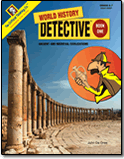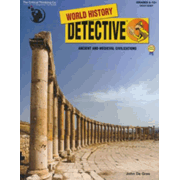World History Detective, Book 1 can be used as a full history course on its own or as an adjunct to one or more other resources. It is suggested for grades 6 and 7, but I think it would also work for eighth graders.
This large, 362-page book is divided into 78 lessons under the headings of Prehistory, Ancient Civilizations, Medieval Civilizations, and Early American Civilizations. Each lesson consists of one to two pages of information, a series of nine multiple-choice questions, one or two essay questions, and a graphic organizer activity page.
The information is rather dry—lots of factual information along with maps, timelines, and occasional illustrations. Every sentence has an identifying paragraph and sentence number which becomes important when students answer the questions. Many of the multiple-choice questions are followed by one or more lines for the student to identity which sentence or sentences best support their answers. This requires close reading by the students and eliminates guessing at multiple-choice answers. Even the multiple-choice answers are often worded differently enough from the lesson material that students really need to think about what they have read to answer correctly.
Essay questions such as “Explain why Asia’s rivers were so important to early settlers” on page 249 require students to synthesize material they have read and respond with answers supported with data from the reading material. Although lines for writing follow each question, there doesn’t appear to be enough space for students to answer most of these directly in the book. I would suggest maintaining a separate notebook for essay responses rather than having some in the book and some elsewhere.
Graphic organizers at the end of each lesson help students to visually arrange information—another way to reinforce learning.
The book is written from a secular perspective. The Prehistory section supports belief in evolution and an old age for the earth. Much information in this section remains debatable although it is presented as factual. On the other hand, coverage through the rest of the book includes religious developments and the impact of religion on cultures and events, something lacking in many secular history resources.
A complete answer key is at the back of the book. Answers include key points that should be included in essay responses. All pages are perforated, so you can remove student pages lesson by lesson and give them to students to complete, or you can remove the answer key and keep the rest of the book intact.
World History Detective, Book 1 seems best suited for use alongside a story approach to history such as we encounter in Story of the World (SOTW) by Susan Wise Bauer. While it contains fairly comprehensive information, the strictly-factual presentation would benefit from the interspersion of stories. Volumes 1 and 2 of SOTW might fit well with it. They cover events from most of the civilizations and time periods of World History Detective, Book 1, although the latter stops before the Reformation which is taught at the end of SOTW Volume 2. SOTW’s storytelling approach needs enhancement for student responses and activities. While these are built into SOTW’s study guides, those using the books by themselves with older students might find World History Detective easier to use since students should be able to complete all of their work independently.
World History Detective accomplishes more than just teaching world history. It also can replace reading comprehension activities since that is a major function of the lessons. It might provide a significant amount of composition activity, especially if you use the opportunity to help students develop essay writing skills. Depending upon how often you use the lessons, students can complete World History Detective, Book 1 in one or more years. A one-year schedule would require at least two lessons per week, but using it alongside another program over a longer period of time should work fine too. Book 2 will cover modern world history.











